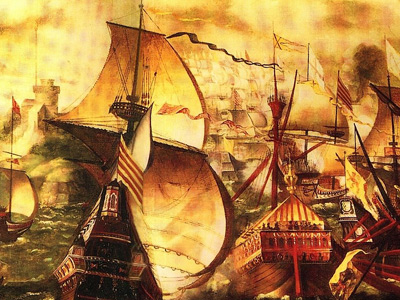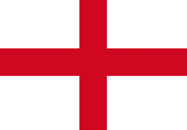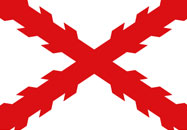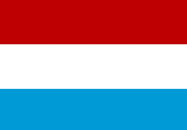Spanish Armada (1588)
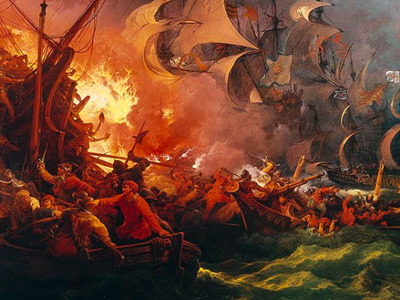
First Actions (1588)
On 20 July the English fleet was off Eddystone Rocks, with the Armada upwind to the west. That night, in order to execute their attack, the English tacked upwind of the Armada, thus gaining the weather gage, a significant advantage. At daybreak on 21 July the English The Kingdom of England was a sovereign state on the island of Great Britain from about 927, when it emerged from various Anglo-Saxon kingdoms, until 1 May 1707, when it united with Scotland to form the Kingdom of Great Britain. The Viking invasions of the 9th century upset the balance of power between the English kingdoms, and native Anglo-Saxon life in general. The English lands were unified in the 10th century in a reconquest completed by King Æthelstan in 927. fleet engaged the Armada off Plymouth near the Eddystone rocks. The Armada was in a crescent-shaped defensive formation, convex towards the east. The galleons and great ships were concentrated in the centre and at the tips of the crescent's horns, giving cover to the transports and supply ships in between. Opposing them the English were in two sections, Drake to the north in Revenge with 11 ships, and Howard to the south in Ark Royal with the bulk of the fleet.
The Kingdom of England was a sovereign state on the island of Great Britain from about 927, when it emerged from various Anglo-Saxon kingdoms, until 1 May 1707, when it united with Scotland to form the Kingdom of Great Britain. The Viking invasions of the 9th century upset the balance of power between the English kingdoms, and native Anglo-Saxon life in general. The English lands were unified in the 10th century in a reconquest completed by King Æthelstan in 927. fleet engaged the Armada off Plymouth near the Eddystone rocks. The Armada was in a crescent-shaped defensive formation, convex towards the east. The galleons and great ships were concentrated in the centre and at the tips of the crescent's horns, giving cover to the transports and supply ships in between. Opposing them the English were in two sections, Drake to the north in Revenge with 11 ships, and Howard to the south in Ark Royal with the bulk of the fleet.
Given the Spanish The Spanish Empire was a colonial empire governed by Spain and its predecessor states between 1492 and 1976. One of the largest empires in history, it was the first to usher the European Age of Discovery and achieve a global scale, controlling vast territory. It was one of the most powerful empires of the early modern period, reaching its maximum extent in the 18th century. advantage in close-quarter fighting, the English ships used their superior speed and manoeuvrability to keep beyond grappling range and bombarded the Spanish ships from a distance with cannon fire. The distance was too great for this to be effective, however, and at the end of the first day's fighting neither fleet had lost a ship in action, although the Spanish carrack Rosario and galleon San Salvador were abandoned after they collided. When night fell, Francis Drake turned his ship back to loot the abandoned Spanish ships, capturing supplies of much-needed gunpowder, and gold. However, Drake had been guiding the English fleet by means of a lantern. As a result of him snuffing out the lantern to slip away from the Spanish ships, the rest of his fleet became scattered and was in complete disarray by dawn. It took an entire day for the English fleet to regroup and the Armada gained a day's grace. The English ships again used their superior speed and manoeuvrability to catch up with the Spanish fleet after a day of sailing.
The Spanish Empire was a colonial empire governed by Spain and its predecessor states between 1492 and 1976. One of the largest empires in history, it was the first to usher the European Age of Discovery and achieve a global scale, controlling vast territory. It was one of the most powerful empires of the early modern period, reaching its maximum extent in the 18th century. advantage in close-quarter fighting, the English ships used their superior speed and manoeuvrability to keep beyond grappling range and bombarded the Spanish ships from a distance with cannon fire. The distance was too great for this to be effective, however, and at the end of the first day's fighting neither fleet had lost a ship in action, although the Spanish carrack Rosario and galleon San Salvador were abandoned after they collided. When night fell, Francis Drake turned his ship back to loot the abandoned Spanish ships, capturing supplies of much-needed gunpowder, and gold. However, Drake had been guiding the English fleet by means of a lantern. As a result of him snuffing out the lantern to slip away from the Spanish ships, the rest of his fleet became scattered and was in complete disarray by dawn. It took an entire day for the English fleet to regroup and the Armada gained a day's grace. The English ships again used their superior speed and manoeuvrability to catch up with the Spanish fleet after a day of sailing.

English ships and the Spanish Armada, August 1588

English ships and the Spanish Armada, August 1588
( Click image to enlarge)
The English fleet and the Armada engaged once more on 23 July, off Portland. This time a change of wind gave the Spanish the weather-gage, and they sought to close with the English, but were foiled by the smaller ships' greater manoeuvrability. At one point Howard formed his ships into a line of battle, to attack at close range bringing all his guns to bear, but this was not followed through and little was achieved.
If the Armada could create a temporary base in the protected waters of the Solent (a strait separating the Isle of Wight from the English mainland), they could wait there for word from Parma's army. However, in a full-scale attack, the English fleet broke into four groups – Martin Frobisher of Aid now also being given command over a squadron – with Drake coming in with a large force from the south. At the critical moment Medina Sidonia sent reinforcements south and ordered the Armada back to open sea to avoid The Owers shoals. There were no other secure harbours further east along England's south coast, so the Armada was compelled to make for Calais, without being able to wait for word of Parma's army.
On 27 July, the Armada anchored off Calais in a tightly-packed defensive crescent formation, not far from Dunkirk, where Parma's army, reduced by disease to 16,000, was expected to be waiting, ready to join the fleet in barges sent from ports along the Flemish coast. Communication had proven to be far more difficult than anticipated, and it only now became known that this army had yet to be equipped with sufficient transport or assembled in the port, a process which would take at least six days, while Medina Sidonia waited at anchor; and that Dunkirk was blockaded by a Dutch The Dutch Republic was a confederation that existed from 1579, during the Dutch Revolt, to 1795. It was a predecessor state of the Netherlands and the first fully independent Dutch nation state. Although the state was small and contained only around 1.5 million inhabitants, it controlled a worldwide network of seafaring trade routes. The income from this trade allowed the Dutch Republic to compete militarily against much larger countries. It amassed a huge fleet of 2,000 ships, initially larger than the fleets of England and France combined. fleet of thirty flyboats under Lieutenant-Admiral Justinus of Nassau. Parma wanted the Armada to send its light pataches to drive away the Dutch, but Medina Sidonia could not do this because he feared that he might need these ships for his own protection. There was no deep-water port where the fleet might shelter – always acknowledged as a major difficulty for the expedition – and the Spanish found themselves vulnerable as night drew on.
The Dutch Republic was a confederation that existed from 1579, during the Dutch Revolt, to 1795. It was a predecessor state of the Netherlands and the first fully independent Dutch nation state. Although the state was small and contained only around 1.5 million inhabitants, it controlled a worldwide network of seafaring trade routes. The income from this trade allowed the Dutch Republic to compete militarily against much larger countries. It amassed a huge fleet of 2,000 ships, initially larger than the fleets of England and France combined. fleet of thirty flyboats under Lieutenant-Admiral Justinus of Nassau. Parma wanted the Armada to send its light pataches to drive away the Dutch, but Medina Sidonia could not do this because he feared that he might need these ships for his own protection. There was no deep-water port where the fleet might shelter – always acknowledged as a major difficulty for the expedition – and the Spanish found themselves vulnerable as night drew on.
The Dutch flyboats mainly operated in the shallow waters off Zeeland and Flanders that larger warships with a deeper draught, like the Spanish and English galleons, could not safely enter. The Dutch therefore enjoyed an unchallenged naval advantage in these waters, even though their navy was inferior in naval armament. An essential element of the plan of invasion, as it was eventually implemented, was the transportation of a large part of Parma's Army of Flanders as the main invasion force in unarmed barges across the English Channel. These barges would be protected by the large ships of the Armada. However, to get to the Armada, they would have to cross the zone dominated by the Dutch navy, where the Armada could not go. This problem seems to have been overlooked by the Spanish planners, but it was insurmountable. Because of this obstacle, England never was in any real danger, at least from the Duke of Parma and the Army of Flanders. Because of the eventual English victory at sea, the Army of Flanders escaped the drowning death Justinus and his men had in mind for them, ready to fight another day.
At midnight on 28 July, the English set alight eight fireships, sacrificing regular warships by filling them with pitch, brimstone, some gunpowder and tar, and cast them downwind among the closely anchored vessels of the Armada. The Spanish feared that these uncommonly large fireships were "hellburners", specialised fireships filled with large gunpowder charges, which had been used to deadly effect at the Siege of Antwerp. Two were intercepted and towed away, but the remainder bore down on the fleet. Medina Sidonia's flagship and the principal warships held their positions, but the rest of the fleet cut their anchor cables and scattered in confusion. No Spanish ships were burnt, but the crescent formation had been broken, and the fleet now found itself too far to leeward of Calais in the rising southwesterly wind to recover its position. The English closed in for battle.
HISTORY
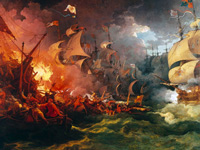
RESOURCES
This article uses material from the Wikipedia article "Spanish Armada", which is released under the Creative Commons Attribution-Share-Alike License 3.0.
© Stories Preschool. All Rights Reserved.
